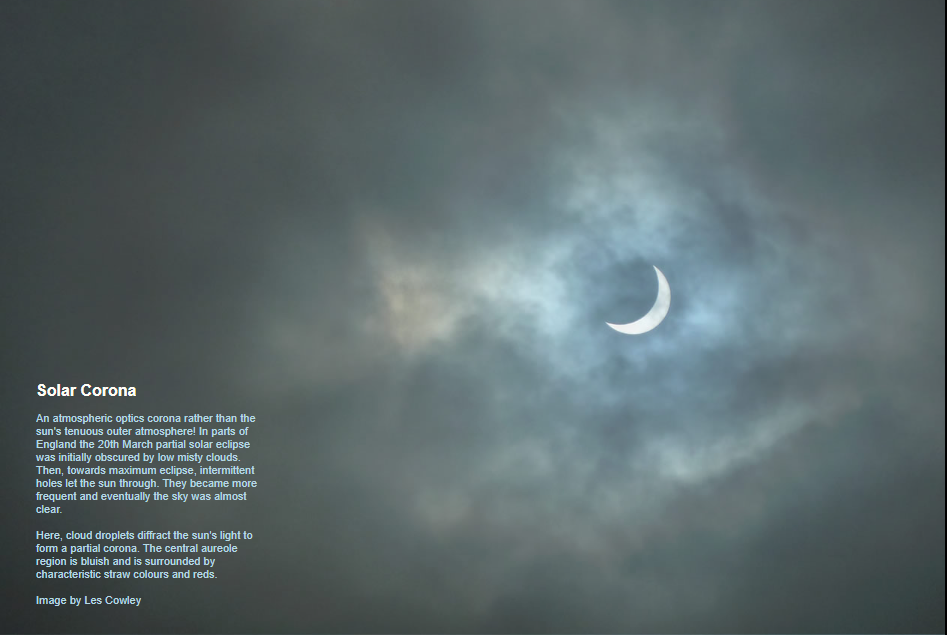Solar Eclipse Atmospheric Corona - OPOD
Solar Eclipse Atmospheric Corona - A Spectacular Phenomenon
A solar eclipse is a mesmerizing celestial event that captivates people around the world. During a partial solar eclipse, like the one observed on the 20th of March, an atmospheric optics corona can be seen instead of the sun's tenuous outer atmosphere. This phenomenon was witnessed in parts of England, where the eclipse was initially obscured by low misty clouds. However, as the eclipse progressed towards its maximum phase, intermittent holes in the clouds allowed glimpses of the sun. These openings became more frequent, eventually revealing a nearly clear sky.
In this captivating image captured by Les Cowley, we can observe how cloud droplets diffract the sun's light, giving rise to a stunning partial corona. The central aureole region appears bluish and is surrounded by characteristic straw colors and reds. This ethereal display is a result of light scattering primarily by the outer skins of cloud droplets.
To understand the formation of a corona, we must delve into the minuscule world of cloud droplets. These droplets are incredibly tiny, with diameters ranging from 1 to 100 microns (0.001 - 0.1 mm). Interestingly, these dimensions are not far removed from the wavelengths of visible light. As a result, the wave aspect of light becomes crucial when it interacts with these minute spheres.
When light encounters cloud droplets, scattered waves radiate outward from all points on the droplet's surface. The overlapping of these waves leads to interference. Waves that are in-phase reinforce each other, while waves out of phase cancel each other out. The consequence of this interference is the creation of a circular diffraction pattern, which we observe as the coronal diffraction pattern in the sky.
The corona's appearance in the sky serves as a testament to both the minuteness of cloud droplets and the wave nature of light. It is a visual reminder of the intricate interplay between light and matter in our atmosphere.
As we marvel at the beauty of the solar eclipse atmospheric corona, it's important to note that this article has been automatically converted from the old site and may not appear as originally intended. However, you can find the original article here for reference.
In conclusion, witnessing a solar eclipse and the accompanying atmospheric corona is a truly awe-inspiring experience. It reminds us of the wonders of our universe and the intricate mechanisms at play in our atmosphere. The interplay between light and cloud droplets creates a mesmerizing diffraction pattern, resulting in the breathtaking display of colors and hues. Let us continue to appreciate and explore the fascinating world of atmospheric optics, always seeking to uncover the mysteries that lie beyond our everyday perception.

Solar Corona
An atmospheric optics corona rather than the sun's tenuous outer atmosphere! In parts of England the 20th March partial solar eclipse was initially obscured by low misty clouds. Then, towards maximum eclipse, intermittent holes let the sun through. They became more frequent and eventually the sky was almost clear.
Here, cloud droplets diffract the sun's light to form a partial corona. The central aureole region is bluish and is surrounded by characteristic straw colours and reds.
Image by Les Cowley

A corona is the product of light scattered mainly by the outer skins of cloud droplets.
The droplets are only 1-100 micron (0.001 - 0.1 mm) diameter - not that far removed from the wavelengths of visible light. The wave aspect of light therefore becomes important when it impacts on the tiny spheres.
Scattered waves radiate outwards from all points on the drop surface. Where they overlap they interfere. Waves in-phase reinforce and waves out of phase are destroyed. The result is a circular diffraction pattern.
The coronal diffraction pattern is a sign writ large in the sky of the minuteness of cloud drops and the wave aspect of light.
Note: this article has been automatically converted from the old site and may not appear as intended. You can find the original article here.
Reference Atmospheric Optics
If you use any of the definitions, information, or data presented on Atmospheric Optics, please copy the link or reference below to properly credit us as the reference source. Thank you!
-
<a href="https://atoptics.co.uk/blog/solar-eclipse-atmospheric-corona-opod/">Solar Eclipse Atmospheric Corona - OPOD</a>
-
"Solar Eclipse Atmospheric Corona - OPOD". Atmospheric Optics. Accessed on November 23, 2024. https://atoptics.co.uk/blog/solar-eclipse-atmospheric-corona-opod/.
-
"Solar Eclipse Atmospheric Corona - OPOD". Atmospheric Optics, https://atoptics.co.uk/blog/solar-eclipse-atmospheric-corona-opod/. Accessed 23 November, 2024
-
Solar Eclipse Atmospheric Corona - OPOD. Atmospheric Optics. Retrieved from https://atoptics.co.uk/blog/solar-eclipse-atmospheric-corona-opod/.